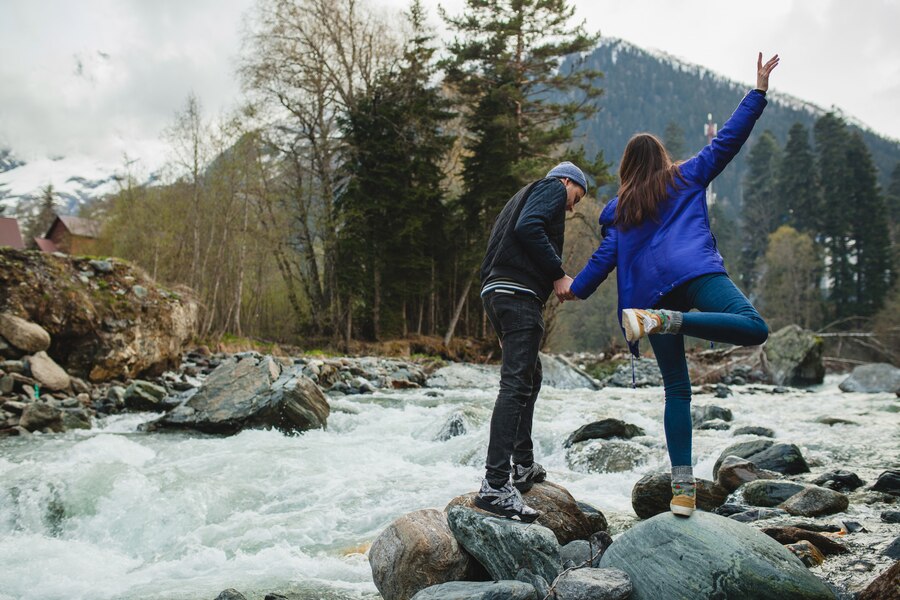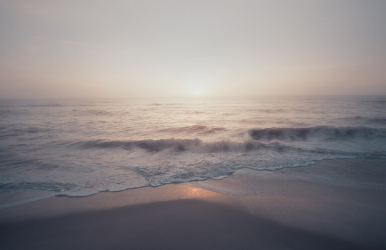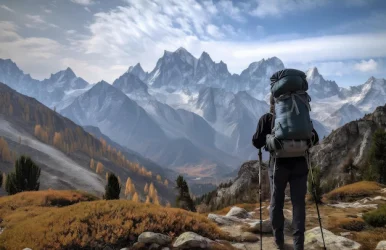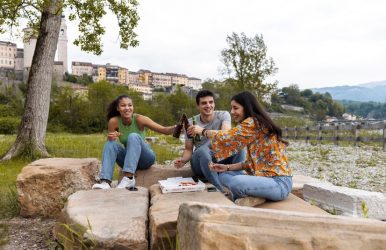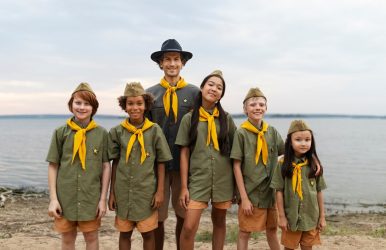Here’s A Quick Guide To The Top 12 Hiking Destinations In The US
BY Ankita Nov 30, 2023
With an astonishing variety of landscapes and mountain ranges, the US is truly a hiker's paradise. From the towering peaks in Montana to the sun-drenched trails in California, there is an adventure for every outdoor enthusiast. This guide will take you through some of the best hiking destinations in the US, each offering its unique allure and unforgettable experiences. 1. Glacier National Park, Montana Renowned for its stunning vistas and diverse wildlife, Glacier National Park offers some of the best hiking trails in the United States. The Grinnell Glacier Trail is a favorite, known for its breathtaking views of glaciers and lakes. The Highline Trail offers panoramic views of the park's rugged terrain. For a glimpse of the park's diverse ecosystems, the Iceberg Lake Trail is unbeatable, leading to a spectacular lake with floating icebergs. The Hidden Lake Overlook Trail provides picturesque views of Hidden Lake and the surrounding peaks, making it a must-visit for any hiker. 2. Zion National Park, Utah Utah’s Zion National Park is a treasure trove of scenic trails that offer diverse hiking experiences. This is a unique hike where you wade through the Virgin River, enclosed by towering canyon walls. This adventure offers a refreshing and exhilarating experience as you navigate through the river's shallow waters and admire the massive, narrow canyons. Angel's Landing offers a thrilling hike with extended views of Zion Canyon, combining physical challenges with a vast overlook. For a more serene experience, the Emerald Pools trail offers a peaceful walk with beautiful waterfalls and lush vegetation. Observation Point gives you bird’s-eye views of the entire park. It’s a favorite among photographers. 3. Grand Teton National Park, Wyoming Grand Teton National Park in Wyoming boasts more than 200 miles of trails, catering to every level of hiker. The Cascade Canyon Trail winds through rocky mountain scenery and diverse wildlife, making it a top pick among hikers. For those seeking the park’s full spectrum, the challenging climb up to Delta Lake rewards with crystal-clear waters and a striking landscape. The Jenny Lake Loop is less strenuous. It skirts the lake’s shoreline, offering serene views of the Tetons reflected in the lake. Taggart Lake Trail provides easy terrain and a picturesque ending at the lake, is perfect for families or a relaxed day hike. 4. Yosemite National Park, California Yosemite National Park offers some of the most scenic trails in the United States. Mist Trail leads to the iconic Vernal and Nevada Falls where the payoff is unique water features. For a challenging hike, Half Dome is a must-try. It’s a thrilling journey, culminating in a steep cable-assisted final climb. This challenging hike rewards the brave with unparalleled views of the Sierra Nevada and Yosemite Valley below. Another gem, the Glacier Point Trail, offers easier access to the grand vistas of Yosemite Valley. For those seeking tranquility, Tuolumne Meadows presents serene paths through high-elevation meadows and granite landscapes. The John Muir Trail winds through the park. It’s ideal for experienced hikers seeking a multi-day adventure. 5. Rocky Mountain National Park, Colorado Rocky Mountain National Park boasts a variety of trails that cater to all skill levels. The park's diverse landscape ranges from lush forests and serene lakes to rugged peaks, offering breathtaking views. One of the most popular trails is the Emerald Lake Trail, a relatively easy hike leading to three alpine lakes. For a more challenging adventure, the Sky Pond Trail winds through beautiful scenery, culminating at a secluded mountain pond. History enthusiasts will appreciate the Flattop Mountain Trail, which ascends to a summit with perspective views, tracing paths used by early park explorers. Wildlife sightings, especially of elk and bighorn sheep, are common, adding a thrilling element to the hikes. 6. Grand Canyon, Arizona A hike in the Grand Canyon is a bucket-list experience for any hiking enthusiast. The Bright Angel Trail is a classic, descending into the canyon with endless passages and historical rest houses along the way. It's ideal for both day hikes and overnight trips, The North Kaibab Trail is the only maintained trail into the canyon from the North Rim. It offers diverse ecosystems and dramatic views of the inner canyon. Though steeper and without shade, The South Kaibab Trail rewards hikers with overarching views, especially at Ooh Aah Point and Skeleton Point. The Rim-to-Rim hike, combining North and South Kaibab Trails, is a once-in-a-lifetime experience for seasoned hikers, showcasing the canyon's vastness and geological wonders. 7. Pisgah National Forest, North Carolina Located deep in the Appalachian Mountains of western North Carolina, Pisgah National Forest offers a variety of exceptional hiking trails. One of the most famous is the Looking Glass Rock Trail, a strenuous 6.5-mile round trip that rewards hikers with amazing payoff views. Another notable trail is the John Rock Loop, a 5-mile journey that provides breathtaking views of the surrounding mountains and forest. For waterfall enthusiasts, the Moore Cove Falls Trail is a must-visit, offering an easy 1.5-mile round trip to a picturesque waterfall. The challenging but rewarding Art Loeb Trail, spanning 30 miles, traverses diverse landscapes and offers an immersive experience in the heart of the forest. 8. Olympic National Park, Washington Olympic National Park in Washington offers over 600 miles of trails. From the majestic mountain peaks to the enchanting rainforests and rugged coastlines, there is something for everyone to explore. One of the popular trails is the Hurricane Ridge Trail to Hurricane Hill, offering breathtaking views of the surrounding mountains. The Sunrise Ridge via the Sunrise Point Trail takes you through beautiful wildflower meadows. Another notable trail is the Klahhane Ridge Trail to Mount Angeles, rewarding hikers with 360-degre lookouts. Don't miss the picturesque Marymere Falls, the adventurous Mount Storm King, and the cascading Sol Duc Falls. 9. Pictured Rocks National Lakeshore, Michigan Pictured Rocks National Lakeshore offers some of the most stunning hikes in Michigan. At 10 miles long, the Chapel Loop is a must-see with its breathtaking views of Chapel Falls, Chapel Rock, and Lake Superior. For a shorter journey, Mosquito Falls Trail is a 4-mile round trip that leads hikers through lush forests to a charming waterfall. Miners Castle Trail is an easy 0.6-mile hike that provides a view of the iconic Miners Castle rock formation. If you love lakeside scenery you’ll enjoy the Beaver Basin Overlook trail, a 1.2-mile trek offering views of the Beaver Lake and its pristine surroundings. Each trail in Pictured Rocks National Lakeshore presents a unique slice of Michigan's natural beauty, making it an ideal destination for nature enthusiasts. 10. Acadia National Park, Maine Offering a diverse range of trails that cater to all skill levels, Acadia National Park is a haven for hikers. The Precipice Trail is known for its steep climbs and breathtaking views. It is a challenging hike leading to the summit of Champlain Mountain. This trail is not for the faint-hearted but rewards with long-range views of the park. Jordan Pond Path offers a more tranquil experience, circling the pristine Jordan Pond and providing serene forest and mountain scenery. For a moderate hike, the Gorham Mountain Trail is ideal, winding through varied landscapes and culminating in rugged coastal views. The Beehive Trail, another exhilarating option, combines climbing and hiking, offering a unique adventure with dramatic cliffside views. These hikes in Acadia not only provide physical challenges but also immerse visitors in the park's natural beauty. Read Also: Crucial Hiking Tips To Ensure Your Safety While Hiking Top 7 Outdoor Adventures In Pigeon Forge You Can’t-Miss On The Go: Packing Essentials For Your Next Adventure

